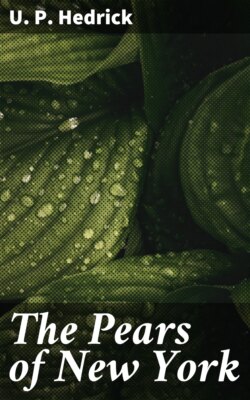Читать книгу The Pears of New York - U. P. Hedrick - Страница 28
На сайте Литреса книга снята с продажи.
ОглавлениеThe latitude of the Smith Astronomical Observatory, a quarter of a mile from the Station orchards, is 42° 52′ 46.2″; the altitude of the orchards is from five hundred to five hundred and twenty-five feet above the sea level. The soil is a loamy but rather cold clay; the orchards lie about a mile west of Seneca Lake, a body of water forty miles in length and from one to three and one-half miles in width and more than six hundred feet deep. The lake has frozen over but a few times since the region was settled, over a hundred years ago, and has a very beneficial influence on the adjacent country in lessening the cold of winter and the heat of summer and in preventing early blooming.
The blooming period is that of full bloom. The data were taken from trees grown under normal conditions as to pruning, distance apart, and as to all other factors which might influence the blooming period. There is a variation of several days between the time of full bloom of the different varieties of pears. These differences can be utilized in selecting sorts to avoid injury from frost. In using blooming-time data it must be kept constantly in mind that varieties of fruits may not bloom in the same relative time. In very warm or very cold springs the usual relations of blooming-time may be upset.
Rainfall, moisture, and cloudiness are most important in growing pears. England, Belgium, and northern France, regions where the pear finds the climate most congenial, have much cool, moist, cloudy weather with much less variation in temperature than is the case in the United States. The climate of New York and the states bordered by the Great Lakes where most of the pears of eastern America are grown, is cooler, moister, and cloudiness is more prevalent than in other eastern states. The summer climate of the Pacific slope is not moist but is equable and, in the best pear orchards, moisture is supplied abundantly by irrigation. From these considerations we may assume that the pear requires more moisture than most other fruits. The pear in New York more often suffers from too little than from too much rain. The exception is when pears are in bloom, at which time the crop is sometimes lost or badly injured by cold, wet weather. Warm, moist weather is favorable to both fire-blight and the scab fungus, the two most dreaded diseases of the pear.
Several other weather problems should be studied before selecting a region as a site for a pear-orchard. The direction, force, and frequency of prevailing winds both in winter and summer are important considerations. Unfavorable winds in winter favor winter-killing; in blooming time prevent the proper setting of fruit; and at ripening time make many windfalls. Hail storms are more frequent in some parts of New York than in others and may be a deterrent in selecting a site. Lastly, drouths, so fatal to the pear, are more common in some parts of the State than in others.
